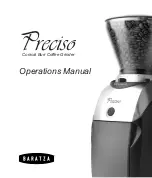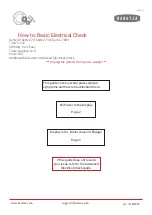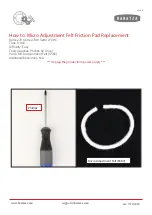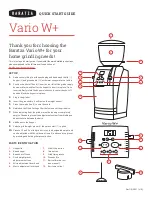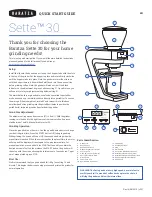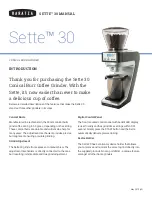
4
04581245_ed2
For front exhaust, insert the Flow Guide tabs into the Exhaust Seal
holes. There is a protrusion on the Exhaust Seal that inserts into
the groove in the top of the Flow Guide. Especially, for Flow Guide
without tabs, be sure this protrusion is inserted in this groove.
Assemble Intake Cover onto Cylinder. There is a tab on the front of
the Intake Cover that inserts into the Exhaust Seal and a tab that
inserts into a hole in the Cylinder for proper alignment.
Place large end of Cylinder on flat hard surface and slide Housing
(12) over Cylinder assembly. Be sure that hole in top of Housing
lines up with hole in Throttle Bushing. Press down on Housing
until these holes are aligned.
Assembly of the Throttle and Inlet
If the Ball Valve Seat (16) was removed, use a 5/8” wooden dowel
with a flat end to push the Seat into the Cylinder.
Assemble Throttle Pin O-Ring (19) onto Throttle Pin (18).
Using needle nose pliers, grasp Throttle Pin above O-Ring and
insert into threaded end of Cylinder. Align Pin with holes in
Cylinder and Housing and insert. Release Throttle Pin and push it
the rest of the way into the hole.
Insert the Ball (4) and then the Ball Valve Spring (3) small end first
into the Cylinder opening.
Assemble Lever Support (6) into Rear Exhaust Diffuser (5), the
U shaped side of support inserted first into front of the Diffuser.
Slide tabs into the slots on the Diffuser and line up the holes with
the holes in the Diffuser.
Assemble Rear Exhaust Diffuser Gasket (8) onto Rear Exhaust
Diffuser and assemble Diffuser onto the Housing Assembly.
Align hole in Lever Assembly (9) with hole in Exhaust Diffuser and
press the Throttle Lever Pin (7) through Exhaust Diffuser holes.
Push the Inlet Screen closed end leading, into the small end of the
Inlet Assembly (1). After lubricating the Inlet Seal (2) with O-Ring
lubricant and being careful not to nick the Seal on the threads of
the Inlet, install the Seal on the Inlet. Press the Ball Valve Spring
Seat small end leading into the small end of the Inlet.
Thread the Inlet Assembly into the Cylinder and tighten it
between 20 to 25 ft–lb (27.1 to 33.9 Nm) torque.
Assembly of the Motor
If the Rear Rotor Bearing (25) was removed, stand the Rotor (27)
upright on the table of an arbor press with the threaded end
downward. Place the threaded rotor hub into a hole drilled into
a flat, smooth block so that the Rotor rests flat on the large rotor
body. Press the Rear Rotor Bearing onto the hub of the Rotor.
Install the Rear Rotor Bearing Retainer (24) in the groove on the
hub of the Rotor.
Install the Front End Plate (29), counterbored end trailing, onto
the threaded hub of the Rotor. Using finger pressure, press the
Front Seal Cup Assembly (31), felt end trailing, onto the end of
the Front End Plate Spacer (30) that is opposite the large internal
bevel. Continue pressing until the felt end is flush with the end of
the Spacer. Saturate the felt with Ingersoll Rand No. 50 Oil. Place
the assembled Spacer, Seal Assembly trailing, onto the threaded
hub of the Rotor. Make sure the Seal Assembly enters the recess in
the Front End Plate.
NOTICE
Before performing the next step, be aware that the Front Rotor
Bearing is a flush ground bearing and must be installed in a
specific manner. The end of the Bearing with a stain or hash
marks must be away from the Spacer.
4. Stand the small hub of the Rotor on the table of an arbor press
with the threaded end upward and press the Front Rotor Bearing
(32) onto the hub of the Rotor.
5. Grasp the assembled Rotor in soft-sided vise jaws with the
threaded rotor hub upward.
6. Thread the Bevel Pinion (66) or Spindle Bearing Nut (59 or 41)
onto the Rotor and using a torque wrench, tighten the Pinion or
Nut between 14 and 19 ft-lb (19.0 and 25.8 Nm) torque.
7. Inject approximately 0.7 cm3 of Ingersoll Rand No. 68 Grease into
8.
9.
1.
2.
3.
4.
5.
6.
7.
8.
9.
1.
2.
3.
the small recess at the bottom of the Cylinder (17). Drop the two
Rear Rotor Bearing Spacers (26) into the bottom of the Cylinder.
8. Wipe each Vane (28) with a light film of oil and insert Vane into
each vane slot in the Rotor. Be sure that logo on Vane faces to the
left inside the vane slot when looking down length of Rotor, with
threaded end away.
9. Grasp the Bevel Pinion or Spindle Bearing Nut and insert the
assembled Rotor into the Cylinder.
10. Assemble the Front Muffler (33) into the Front Housing Cap (34).
Ensure muffler is installed in the Cap and does not get pushed
down into the Motor Housing.
11. Assemble Front Housing Cap onto Motor Housing (12), aligning
notches on Cap with notches in the Cylinder. Place Flange Clamp
(35) in groove in Cap.
Assembly of the Extension Housing on G2E and G2L
Models.
For G2E Models, if the Rear Spindle Bearing (44) was replaced,
proceed as follows:
a. Stand the Extension Housing (43) on the table of an arbor press
with the small end downward.
b. Press the Bearing into the Housing until the trailing end of the
Bearing is 1.408” to 1.418” (35.7 mm to 36.0 mm) below the face
of the large end of the Extension Housing.
2. If the Front Spindle Bearing (46) was replaced, stand the Spindle
(45) on the table of an arbor press, small threaded end upward.
Being careful not to damage the threads on the large end of the
Spindle, press the Bearing, stained or marked end trailing, onto
the Spindle until it seats against the shoulder of the shaft.
3. Using an adjustable wrench on the flats of the Spindle and a
9/16” wrench on the Bevel Pinion (47), thread the Pinion onto the
Spindle against the Bearing and tighten it between 14 and 19
ft–lb (19.0 and 25.8 Nm) torque.
4. Using an adjustable wrench on the Spindle and a 1/2” wrench
on one of the Spindle Bearing Nuts (41), thread Nut without the
Coupling Retaining Ring (42), counterbored end leading, onto the
Spindle. Tighten the Nut between 14 and 19 ft–lb (19.0 and 25.8
Nm) torque.
5. Insert the assembled Spindle, Nut end leading, into the small end
of the Extension Housing. Push the assembly into the Housing
until the Front Spindle Bearing bottoms on the housing shoulder.
6. Using snap ring pliers, install the Coupling Retaining Ring on
the Spindle Bearing Nut protruding into the large end of the
Extension Housing.
7. Grasp the assembled Motor Housing, mounted in Clamp Tool
(96), in soft-sided vise jaws with the Spindle Bearing Nut (41)
upward. Coat the inside of the Arbor Coupling 04581245_ed1
EN-4 EN (39) with approximately 1 cm3 of Ingersoll Rand No. 68
Grease and install the Coupling over the Bearing Nut. Position the
Clamp Sleeve (40) over the Coupling in the ;Motor Housing.
8. Insert the Spindle Bearing Nut in the assembled Extension
Housing into the Arbor Coupling and thread the Extension
Housing onto the Cylinder. This is a lefthand thread; rotate the
Extension Housing counterclockwise to tighten it. Tighten the
Housing between 20 to 25 ft-lb (27.1 to 33.9 Nm) torque.
9. For G2L Models, if the Rear Spindle Bearing (62) was replaced,
stand the Spindle (64) on the table of an arbor press and being
careful not to damage the threads on the Spindle, press the
Bearing onto the Spindle until it seats against the shoulder of the
shaft.
10. If the Front Spindle Bearing (65) was replaced, invert the Spindle
on the table of an arbor press and being careful not to damage
the threads on the Spindle, press the Bearing, stained or marked
end trailing, onto the Spindle until it seats against the shoulder of
the shaft.
11. Grasp a 5/32” diameter steel pin vertically in a set of vise jaws and
slide the crosshole of the Spindle down onto the pin.
12. Using a 9/16” wrench on the flats of the Bevel Pinion (66), thread
the Pinion onto the Spindle against the Bearing and tighten it
between 14 and 19 ft–lb (19.0 and 25.8 Nm) torque.
1.









